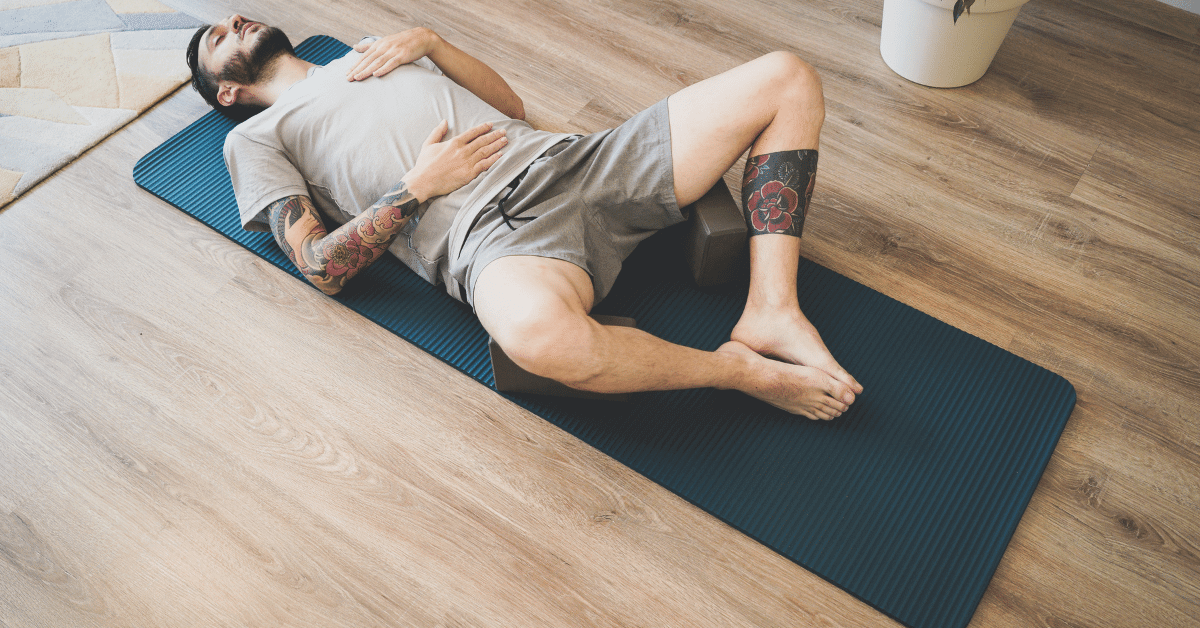Diaphragmatic breathing is a way to breathe using the diaphragm muscle 1. It’s deeper than normal breathing and different from shallow breathing. This method helps you manage stress better, improve lung function, and boost your overall health.
How do I perform diaphragmatic breathing correctly?
To perform diaphragmatic breathing, lie back or sit comfortably and place one hand on your belly and the other on your chest. Inhale deeply through your nose, ensuring your abdomen rises more than your chest. Exhale slowly through pursed lips, feeling the abdomen lower.
This blog is part of a series on “breathing techniques.” The next blog is about 4-7-8 breathing.
Key Tips for Mastering Diaphragmatic Breathing
- Start by finding a quiet place where you can relax without interruptions.
- Lie on your back with a pillow under your knees and head to ensure comfort.
- Place one hand on your abdomen and the other on your chest to feel the correct movement.
- Inhale slowly through your nose, focusing on making your abdomen rise more than your chest.
- Exhale slowly through pursed lips, trying to keep the exhalation steady and controlled.
- Practice these steps for five to ten minutes daily to become more proficient.
- Consult with a healthcare professional if you have conditions like asthma or COPD.
How to Practice Diaphragmatic Breathing Effectively
To start diaphragmatic breathing, lie flat on your back with a pillow under your knees and another under your head. Place one hand on your chest and the other on your abdomen. Breathe slowly through your nose, ensuring your abdomen rises above your chest. This technique allows your diaphragm to engage more fully. Try to keep the hand on your chest as still as possible.
Next, exhale slowly through pursed lips, like you’re blowing out a candle. This helps maintain a slower, controlled breath, which is key in diaphragmatic breathing exercises. Repeat this cycle three to four times. Focus on keeping your neck and shoulders relaxed to avoid straining. Practicing this daily can strengthen your diaphragm and increase lung capacity.
Diaphragmatic breathing can help manage symptoms for those with COPD or asthma. It reduces the effort needed to breathe and may enhance overall lung efficiency. Please consult a healthcare provider to tailor these exercises to your needs and ensure you’re performing them correctly.
Deep Breathing Exercises to Complement Diaphragmatic Techniques
Deep breathing exercises, alongside diaphragmatic techniques, enhance relaxation and lung function. Start by sitting comfortably with your back straight. Inhale deeply through your nose, allowing your lungs to fill and your rib cage to expand. Then, exhale slowly through your mouth.
Try the ‘4-7-8’ method, where you inhale for four seconds, hold your breath for seven seconds, and exhale for eight seconds. This method promotes relaxation and helps to steady your breathing rhythm. Performing these exercises daily can lead to better stress management and reduced anxiety.
| Technique | Primary Benefits | Use Cases |
|---|---|---|
| Diaphragmatic Breathing | Enhances lung efficiency, reduces stress, improves digestion | Stress management, respiratory issues, general wellness |
| Deep Breathing | Increases oxygen exchange, promotes relaxation, stabilizes mood | Meditation, anxiety relief, relaxation techniques |
Incorporate visualization to enhance the effect; imagine the tension leaving your body with each exhale. This mental practice can further deepen the relaxation effects of deep breathing, making it a powerful tool for managing everyday stress and improving your breathing technique.
The Health Benefits of Regular Diaphragmatic Breathing
Regular diaphragmatic breathing offers several benefits for physical and mental health. It improves your blood’s oxygenation, enhancing energy levels and supporting better sleep. It also plays a crucial role in reducing stress by lowering your body’s stress hormone cortisol.
For individuals with respiratory conditions such as chronic obstructive pulmonary disease (COPD) or asthma, this type of breathing may help improve lung capacity and efficiency. It also aids in the management of pain and can decrease overall anxiety, contributing to a calmer state of mind.

Engaging regularly in diaphragmatic breathing can boost immune system performance and support digestion. The relaxation induced by proper breathing techniques can help alleviate irritable bowel syndrome (IBS) symptoms and other digestive issues.
Incorporating Diaphragmatic Breathing into Meditation and Yoga
Diaphragmatic breathing is a cornerstone technique in meditation and yoga, enhancing these practices’ spiritual and physical benefits. Begin your yoga session by focusing on deep, diaphragmatic breaths to settle your mind and prepare your body for exercise.
Use diaphragmatic breathing to anchor your awareness and deepen your relaxation in meditation. This type of breathing helps regulate the nervous system, easing you into a meditative state. It allows for a deeper connection with the self and promotes a greater sense of peace and mindfulness.
Integrating diaphragmatic breathing into these practices can enhance control over one’s breath and body, leading to more effective sessions. Regular practice can also improve one’s concentration and help one maintain calm.
Personal Thoughts
Through my battles with chronic stress, I discovered the power of diaphragmatic breathing. It became a cornerstone of my daily routine, offering me a practical tool to reduce my stress levels and enhance my ability to relax.
This technique has helped me manage my stress better and improve my health. I share this in hopes that it can offer the same relief to others struggling with similar challenges.
Frequently Asked Questions
What are the benefits of practicing diaphragmatic breathing?
Practicing diaphragmatic breathing can enhance lung capacity, reduce stress, and improve oxygen supply throughout the body. It also helps manage conditions like anxiety and COPD, promoting relaxation and better sleep patterns due to improved breathing efficiency.
How often should diaphragmatic breathing exercises be performed?
Practice diaphragmatic breathing exercises daily for about five to 10 minutes to see significant benefits. Consistency is key; over time, you may find increasing the duration or frequency beneficial as you become more comfortable with the technique.
Can diaphragmatic breathing help with stress and anxiety?
Yes, diaphragmatic breathing is very effective in managing stress and anxiety. Focusing on deep, controlled breathing activates the body’s relaxation response, which helps lower heart rate and blood pressure, reducing overall stress and promoting a sense of calm.
What is the correct posture for diaphragmatic breathing?
The ideal posture for diaphragmatic breathing involves sitting in a chair with your back straight or lying on a flat surface. Place a pillow under your knees to support relaxation and align your spine. Your shoulders should be relaxed, and your chest should remain still while your belly rises and falls.
Are there any precautions to take while learning diaphragmatic breathing?
When starting with diaphragmatic breathing, it’s important to progress gradually to avoid dizziness or lightheadedness, which can occur if overdone initially. People with health conditions such as COPD or asthma should consult a healthcare provider to tailor the breathing exercises to their needs.




